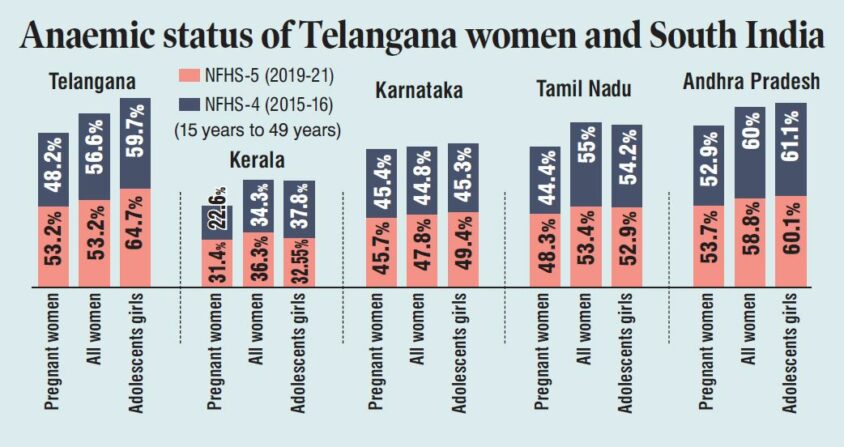Telangana women highly anaemic
State accounts for highest percentage in south India

Hyderabad: Telangana State continues to grapple with a high prevalence of anaemia among women of all ages, including pregnant women, adolescent girls, and women between 15 and 49 years. This is a significant health challenge, particularly given the state’s ranking as the South Indian state with the highest percentage of anaemic women.
Iron-Deficiency anaemia (IDA) is a primary contributor to poor pregnancy outcomes in government hospitals. At present, however, there is limited access to additional nutrition for pregnant women through National Health Mission (NHM) initiative of the Union Health Ministry, New Delhi. The initiative of providing supplementary food has to be extended by the present Telangana State government to all pregnant women and adolescent girls between 15 years and 19 girls, an age group in which a staggering 59.1 percent of girls are anemic in Telangana.
It’s not just adolescent girls, IDA has also remained a major public health issue impacting majority of women, as its among 15 years to 49 years of women is 57.6 percent in Telangana State.
The World Health Organization (WHO) defines anaemia as reduction in haemoglobin concentration, red-cell count, or packed-cell volume below established cut-off levels. According to WHO, anaemia among women is defined as a haemoglobin concentration of less than 120 grams per litre of blood for adolescent girls of less than 15 years and haemoglobin content of less than 110 grams per litre of blood among pregnant women.
Senior health officials have said that IDA is problem among women primarily due to their recurrent menstrual loss. Demand for iron is higher among pregnant women, and women who have anaemia in combination with early onset of child bearing, a high number of births, short intervals between birth and poor access to antenatal care.
A WHO study on Indian women said that daily consumption of iron among Indian women is alarmingly and unacceptably low. The average requirement of iron per day for a person is nearly 13 milligrams (mg) per day and anywhere between 15 mg and 18 mg per day among pregnant women.

Related News
-
Cartoon Today on December 25, 2024
6 hours ago -
Former Home Secretary Ajay Kumar Bhalla appointed Manipur Governor, Kerala Governor shifted to Bihar
6 hours ago -
Opinion: The China factor in India-Nepal relations
7 hours ago -
Editorial: Modi’s Kuwait outreach
7 hours ago -
Kohli and Smith will be dangerous and hungry: Shastri
8 hours ago -
Sharvari shares her TBR list of romantic book titles, suggested by fans
8 hours ago -
Khammam Congress gaffe: Union Home Minister Amit Shah made ‘Defense Minister’
8 hours ago -
Couple held for theft in Hyderabad
9 hours ago




